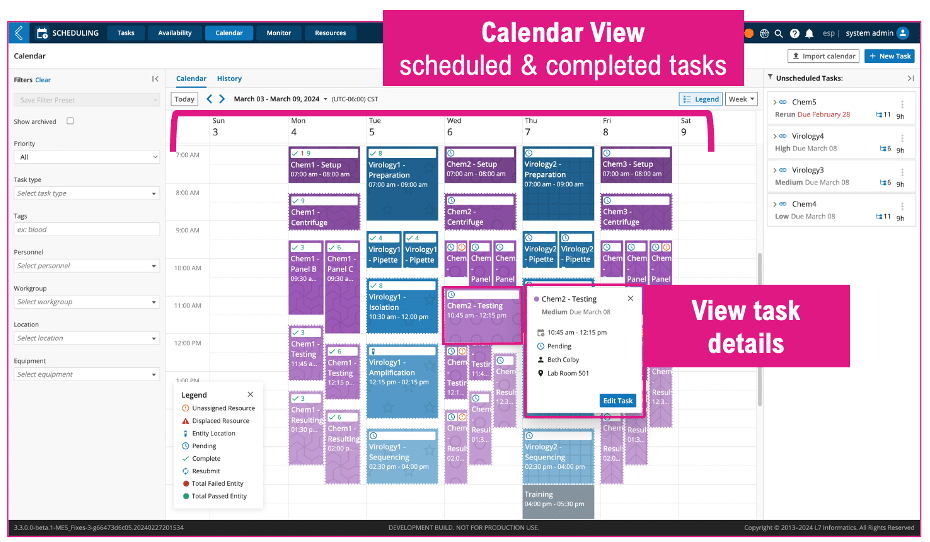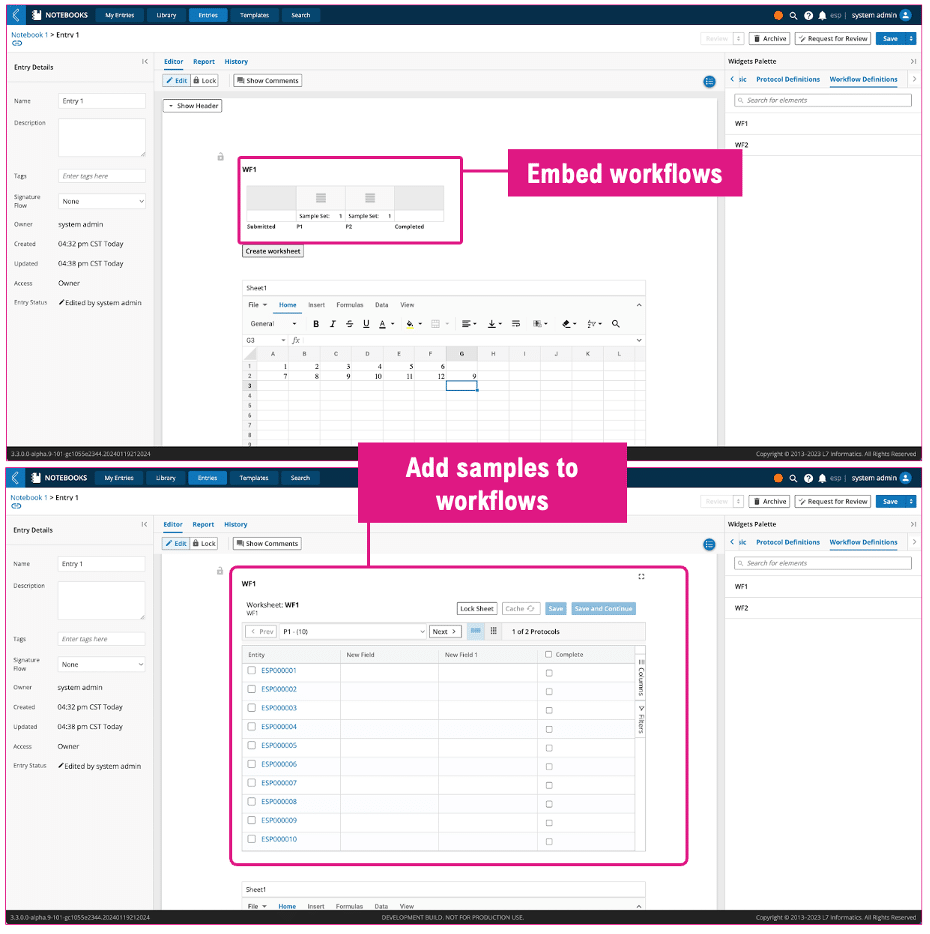L7 | CHATS
product release
We Are Excited To Share Our New Product Release – See What’s Inside L7|ESP v3.3
by Brigitte Ganter, Ph.D. | posted on July 15, 2024
We’re thrilled to launch L7|ESP® v3.3 with significant enhancements and additions across the entire core platform, empowering researchers, therapeutics development and manufacturing staff, diagnostic testing labs, and entire organizations to maximize the return on investment with its Workflow Orchestration and Data Contextualization capabilities. L7|ESP v3.3 does not only include major updates and enhancements to the low code/no-code data model builder L7|MASTER®, the collaboration and deployment portal L7|HUB®, the various lab management and manufacturing applications L7 Notebooks, L7 LIMS, and L7 MES, it also includes adherence to UX/UI best practices guidelines, the release of a set of normalized tables (i.e., Intelligence Table Definitions – ITDs) with support access to entity and process data via L7|INTELLIGENCE®, and the official launch of the fully integrated L7 Scheduling application. As initially stated, L7|ESP v3.3 is a pretty darn good product release you should be eyeing.
The L7|ESP platform v3.3 – with its innovative approach to address laboratory and business management challenges – provides a host of industry-leading advancements that together enable improved business intelligence, comprehensive business velocity, and reduced cost for laboratory and data management professionals and business executives in research, therapeutics, and diagnostics. As such, this new L7|ESP 3.3 version includes a wide range of new capabilities that address the various needs of different end users across those sectors:
- Official launch of L7 Scheduling which benefits individuals who need to schedule resources in the lab, be it personnel, workgroups, location, equipment, or custom resources. The lab managers/directors and program/project managers usually benefit the most from the L7 Scheduling application as they manage and optimize the schedules and utilization of those resources. L7 Scheduling allows defining resource schedules, planning and reviewing of resource capacity, scheduling tasks and assigning resources, reviewing task progress in real-time, and reviewing resource utilization across tasks. Since L7 Scheduling is fully integrated within the L7|ESP Unified Platform with its Workflow Orchestration system, resources are dynamically and automatically linked to entries and schedulable data sources. The outcomes or which are optimized resources and overall cost reduction due to higher laboratory efficiency and cost-effective production of therapies that benefit the entire organization and are most relevant to C-level individuals (e.g., CFO, CEO, COO, CSO, CMO, CTO). Some of the L7 Scheduling highlights include:
- Enables resource scheduling based on priority, expected completion date, and task duration.
- Integrates assignee information with workgroup, location, and selected equipment into the scheduling process. The Calendar View provides all necessary details to view all tasks, whether scheduled or already completed, pending (i.e., scheduled in the future), and Tasks currently undergoing Entity processing via L7 LIMS. Completed Tasks show the total number of passed versus failed Entities.
- Automatically synchronizes with the L7 LIMS application.
- Supports real-world process supply chain complexities and their scheduling.
- Monitors Tasks progress in real time.

Figure 1: Calendar View of scheduled and completed Tasks.
- New features and enhancements to L7|HUB® – L7|HUB is a one-stop-shop for streamlining scientific collaborations, providing a rich library of standard and pre-built scientific content (i.e., methods and scientific protocols | e.g., configurable L7 LIMS Workflows), much like an App library on your phone. The 3.3 L7|HUB updates are particularly important if one team or department needs to transfer technology (i.e., to share standardized digitalized file(s) representing a data or process model) with another department or across sites. To maximize the collaboration value, L7|HUB now allows side-by-side comparison (e.g., data model, YAML code, and Bundle [i.e., scientific methods/protocols] history comparison of scientific content (e.g., Protocols, Workflows, and Workflow Chains)), provides a capability to export Bundle review history, and adding images and supporting files to a Bundle while creating or uploading a Bundle.
- UI Visibility to Intelligence ITDs via L7|INTELLIGENCE® – L7|INTELLIGENCE extensions unlock process and operational insights which allow organizations to harness the power of process data made available via Intelligence ITDs to translate process insights into improved resource utilization, increased business velocity, reduced operational costs, and reduced variability in cycle times. Specifically, with the 3.3 release, a set of normalized tables (i.e., Intelligence Table Definitions [ITDs]), that will provide access to entity and process data, will be made available. This is of particular interest to data and computational scientists that need to extract insight from the data collected during the orchestration of lab and therapeutic manufacturing processes. The data in ITDs can be accessed via API calls or SQL queries or can be used externally to L7|ESP in a data warehouse. Data accessible via ITDs can be browsed and downloaded.
- New features and enhancements to L7 LIMS – The support for Dynamic Execution Plans (DEPs) is paving the way for future support of DOE (Design of Experiment). Support within L7 LIMS allows more unit op-centric procedures that can be tuned for a particular therapeutic test or a site (i.e., production site). In addition, a multi-select picklist is available in the Workflow Chain configuration, which allows builders to set a specific type of DEP, ensuring users must specify an Execution Plan before proceeding when creating an L7 MES batch or an L7 LIMS experiment.
- New features and enhancements to L7 Notebooks – L7 Notebooks uses existing L7|ESP WFC configurations to automate task orchestration, resulting in expedited notebook entries and supporting the execution of Protocols and Workflows from within L7 Notebooks. The plentiful L7 Notebooks additions include a series of different data visualization widgets (e.g., line, bar, and column charts, and scatter plot), intuitive table and navigation widgets, embedded workflows and dynamic linking of all entities, an added Plasmid Editor and Viewer supporting editing, viewing, and annotating of plasmids in various formats, and L7 Notebooks Entry sharing capability which includes inline commenting. The fact that L7 Notebooks is a fully integrated application within L7|ESP provides the capability of embedding workflows within L7 Notebooks Entries, allowing users to use an existing Workflow and embed it, making re-entering data for each step obsolete. This results in a huge benefit to all users (e.g., lab technicians, bench researchers), as it does not only reduce potential re-entry errors, it also reduces the time to set up experiments as users are now able to add existing or new samples to an embedded workflow within an L7 Notebooks Entry to be executed from within the L7 Notebooks Entry (see Figure 2).

Figure 2: Embed Workflows and add samples to Workflows in L7 Notebooks Entry.
- New features and enhancements to L7 MES – The flexible, digital process-oriented L7 MES, which uses existing L7|ESP WFC configurations to automate task orchestration, is designed to overcome traditional pharmaceutical manufacturing bottlenecks by streamlining entire productions while enabling review-by-exception manufacturing. Besides a signature flow enhancement that enables users to sign asynchronously or enforces user uniqueness, a key 3.3 L7 MES update includes customer report branding/labeling with customer logos which is particularly of interest for CDMOs when sharing the Final Batch Report with a pharmaceutical, biotechnology, or medical device clients.
- UI/UX enhancements – To constantly strive for optimal user experience across the entire L7|ESP platform, increased UI/UX alignment with design language was considered; global search was improved with Boolean operators to expedite finding records of interest and deep search through L7 Notebooks Entries, recognizing results in embedded worksheets; improved, granular error messaging and service status visibility was added; improved intuitive L7 Notebooks Entry and navigation was implemented; and added intuitive table generation and spreadsheet widgets are now supported in L7 Notebooks.
Contact us to learn more about the latest L7|ESP release, or visit the L7|ESP webpage to learn more about the L7|ESP platform, with its Workflow Orchestration and Data Contextualization capabilities, and how it could help you with your laboratory and business processes.
